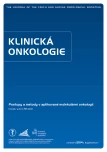Quantitative Mass Spectrometry and Its Utilization in Oncology
Authors:
L. Hernychová; P. Dvořáková; E. Michalová; B. Vojtěšek
Authors‘ workplace:
Regionální centrum aplikované molekulární onkologie, Masarykův onkologický ústav, Brno
Published in:
Klin Onkol 2014; 27(Supplementum): 98-103
Overview
Cancers are genetically and clinically very heterogeneous diseases; therefore, various proteomic studies have been trying to find biomarkers which can facilitate prognosis, diagnosis or treatment of these oncological diseases. The mass spectrometry is an effective tool for identification, quantitation, and characterization of biomolecules in the complex biological samples. The first step suitable for selection of biomarkers called discovery proteomics provides a detailed analysis of the samples contributing to the identification of proteins, comparison of their presence in the samples, and selection of the convenient candidates for the prospective biomarkers. The next step of proteomics analysis is directed towards verification of chosen biomarkers with the approach called targeted proteomics. This technique evaluates presence and quantity of the proteins (biomarkers) in clinically precisely defined samples. This article focuses on the description of various approaches suitable for the quantitative analysis of the proteins connected with mass spectrometry.
Key words:
quantitative proteomics – mass spectrometry – protein – biomarker – oncology – cancer
This work was supported by the European Regional Development Fund and the State Budget of the Czech Republic (RECAMO, CZ.1.05/2.1.00/03.0101) and by MH CZ – DRO (MMCI, 00209805).
The authors declare they have no potential conflicts of interest concerning drugs, products, or services used in the study.
The Editorial Board declares that the manuscript met the ICMJE “uniform requirements” for biomedical papers.
Submitted:
20. 1. 2014
Accepted:
7. 4. 2014
Sources
1. Psort.hgc.jp [homepage on the Internet]. PSORT www Server. University of Tokio, Japan; c2007 [cited 2014 February 17]. Available from: http:/ / psort.hgc.jp/ .
2. Tatusov RL, Galperin MY, Natale DA et al. The COG database: a tool for genome ‑ scale analysis of protein functions and evolution. Nucleic Acids Res 2000; 28(1): 33 – 36.
3. Genome.jp/ kegg [homepage on the Internet]. KEGG: Kyoto Encyclopedia of Genes and Genomes. Kanehisa Laboratories, Japan; c1995 – 2014 [cited 2014 February 17]. Available from: http:/ / www.genome.jp/ kegg/ .
4. Huang DW, Sherman BT, Lempicki RA. Systematic and integrative analysis of large gene lists using DAVID bioinformatics resources. Nat Protoc 2008; 4(1): 44 – 57. doi: 10.1038/ nprot.2008.211.
5. Hsls.pitt.edu/ molbio/ ipa [homepage on the Internet]. Search.HSLS.MolBio, Health Sciences Library system; c1996 – 2014 [cited 2014 February 17]. Available from: http:/ / www.hsls.pitt.edu/ molbio/ ipa.
6. van Iersel MP, Kelder T, Pico AR et al. Presenting and exploring biological pathways with PathVisio. BMC Bioinformatics 2008; 9(1): 399. doi: 10.1186/ 1471 - 2105 - 9 - 399.
7. Mann M. Functional and quantitative proteomics using SILAC. Nat Rev Mol Cell Biol 2006; 7(12): 952 – 958.
8. Ong SE, Blagoev B, Kratchmarova I et al. Stable isotope labeling by amino acids in cell culture, SILAC, as a simple and accurate approach to expression proteomics. Mol Cell Proteomics 2002; 1(5): 376 – 386.
9. Marcilla M, Alpizar A, Paradela A et al. A systematic approach to assess amino acid conversions in SILAC experiments. Talanta 2011; 84(2): 430 – 436. doi: 10.1016/ j.talanta.2011.01.050.
10. Geiger T, Madden SF, Gallagher MW et al. Proteomic portrait of human breast cancer progression identifies novel prognostic markers. Cancer Res 2012; 72(9): 2428 – 2439. doi: 10.1158/ 0008 - 5472.CAN ‑ 11 - 3711.
11. Krüger M, Moser M, Ussar S et al. SILAC mouse for quantitative proteomics uncovers kindlin‑3 as an essential factor for red blood cell function. Cell 2008; 134(2): 353 – 364. doi: 10.1016/ j.cell.2008.05.033.
12. Geiger T, Cox J, Ostasiewicz P et al. Super ‑ SILAC mix for quantitative proteomics of human tumor tissue. Nat Methods 2010; 7(5): 383 – 385. doi: 10.1038/ nmeth.1446.
13. Boersema PJ, Geiger T, Wisniewski JR et al. Quantification of the N ‑ glycosylated secretome by super ‑ SILAC during breast cancer progression and in human blood samples. Mol Cell Proteomics MCP 2013; 12(1): 158 – 171. doi: 10.1074/ mcp.M112.023614.
14. Ross PL, Huang YN, Marchese JN et al. Multiplexed protein quantitation in Saccharomyces cerevisiae using amine ‑ reactive isobaric tagging reagents. Mol Cell Proteomics MCP 2004; 3(12): 1154 – 1169.
15. Rauniyar N, Gao B, McClatchy DB et al. Comparison of protein expression ratios observed by sixplex and duplex TMT labeling method. J Proteome Res 2013; 12(2): 1031 – 1039. doi: 10.1021/ pr3008896.
16. Rehman I, Evans CA, Glen A et al. iTRAQ identification of candidate serum biomarkers associated with metastatic progression of human prostate cancer. PloS One 2012; 7(2): e30885. doi: 10.1371/ journal.pone.0030885.
17. Chen Y, Choong LY, Lin Q et al. Differential expression of novel tyrosine kinase substrates during breast cancer development. Mol Cell Proteomics MCP 2007; 6(12): 2072 – 2087.
18. Liu NQ, Dekker LJ, Stingl C et al. Quantitative proteomic analysis of microdissected breast cancer tissues: comparison of label‑free and SILAC‑based quantification with shotgun, directed, and targeted MS approaches. J Proteome Res 2013; 12(10): 4627 – 4641. doi: 10.1021/ pr4005794.
Labels
Paediatric clinical oncology Surgery Clinical oncologyArticle was published in
Clinical Oncology

2014 Issue Supplementum
- Metamizole vs. Tramadol in Postoperative Analgesia
- Metamizole at a Glance and in Practice – Effective Non-Opioid Analgesic for All Ages
- Metamizole in perioperative treatment in children under 14 years – results of a questionnaire survey from practice
- Obstacle Called Vasospasm: Which Solution Is Most Effective in Microsurgery and How to Pharmacologically Assist It?
- Possibilities of Using Metamizole in the Treatment of Acute Primary Headaches
Most read in this issue
- Protein Expression and Purification
- Methods for Studying Tumor Cell Migration and Invasiveness
- Next Generation Sequencing – Application in Clinical Practice
- Analysis of Protein Using Mass Spectrometry
